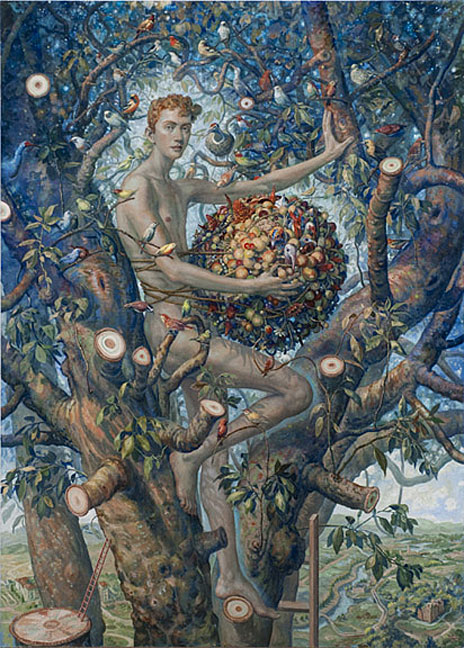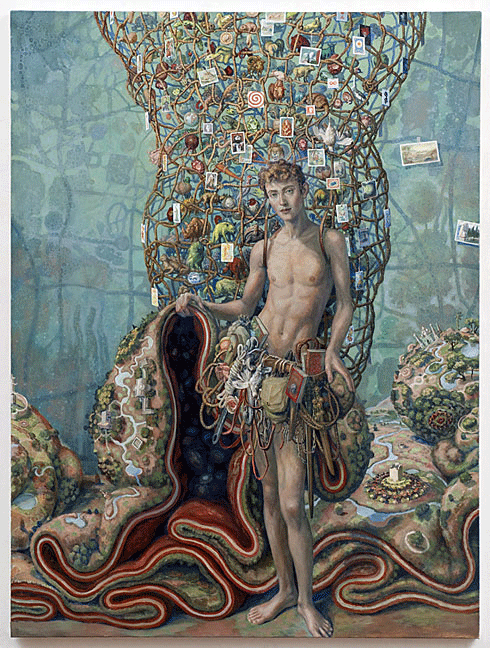
Preparing to send her older son off to college has gotten Julie Heffernan thinking hard about just what a young man needs these days. Of course, a mother who is a Yale educated painter married to a New York Sun theater critic is going to provide much more than a laptop and a futon from Target. A deeply intellectual and articulate artist, Heffernan is all about equipping the mind and the soul. They are, after all, the only tools that really matter.
Known for her allegory laden self-portraits, Heffernan's years of self reflection have come out the other side of middle age in the form of immense empathy for her two sons, and for young people in general. Playing the role of "a well-meaning older person," Heffernan has created a suite of paintings that fantasize a world that is meant to help furnish the dorm room of a young man's inner world.
The images, painted in a pastiche style reflecting the artist's engagement with Old Master paintings, take place in an allegorical landscape perfumed by dense vegetation and perhaps a whiff of opium. They are complex, dense paintings that reflect Heffernan's theatrical imagination: an imagination that art historian Kyle Culpit says scans the world through "...a decidedly feminist lens." Expertly picking up the technical tools and allegorical language of Northern Masters like Hieronymus Bosch and Pieter Breughel, Heffernan manages to simultaneously secularize, feminize and pay homage to the artistic traditions they invented.
Although Heffernan began her series wanting to comment on the "bad" boys of the world who have screwed up government, climate, the economy and more, the paintings couldn't help becoming sweeter as the artist realized that being a mother gave her no other choice than being hopeful. "Let the 'bad' kids have the violent world of video games," Heffernan seems to say, "and I will give the good guys an enchanted forest of ideas where technology is irrelevant."

In "Great Scout Leader III" a young man -- he could easily be a cousin of Botticelli's Venus -- lifts the peeled skin of a cityscape. His doting painter/mother has over-packed him for his allegorical journey, providing both a tool-belt stuffed with books and ropes, and also a latticed backpack inhabited by a bestiary of creatures and hung with icons. He does have a dagger -- just in case -- but there is very little threat implicit in his surroundings. The painting is oddly sweet and confident, and the young man seems calmly ready to manage the considerable complexity surrounding him. In fact, he is meant to thrive in complexity, and he will do so in concert with nature and with his own spirit.
Heffernan's art stands out: not just for its engaged optimism, but also for its pure visual richness. She hasn't held anything back in this show: not surprising for a painter who has no tolerance for art that "impoverishes the eye while purporting to appeal to the mind." Heffernan, whose personal imaginative process -- she calls it image screening -- gives her work tremendous density, is a visionary with more than a few things to tell us. It is that visionary quality, and her impulse to find symbolic expression for moral issues that again remind us of her artistic kinship with Bosch.
Of course, it is hard to know exactly how actual young men will respond to Heffernan's "Boys." In fact, when Heffernan spoke at the San Francisco Art Institute earlier this year, a student asked her what he own son thought of the imagery in her recent paintings and she realized she hadn't talked with him about that.
My bet is that he is very used to his mother's views and ideas, although if he puts up one of her exhibition announcements in his dorm room there may be some explaining to do. The way I imagine it, on Parent's Day, Julie Heffernan's son will introduce her to his freshman roommate. While gently rolling his eyes, he will say, with genuine affection:
"I'd like you to meet my mother, Hieronymus Bosch. "
Q and A: John Seed Interviews Julie Heffernan
JS:
Do the paintings in "Boy, O Boy" connect to your experiences as the mother of two sons?
JH:
They do connect, but I only realized that late in the process of painting them. I started out thinking that the paintings of the boys were going to be about all the "bad" boys out there messing up our world/climate/government/economy, which I wanted to rant about in this body of work.
In the course of making the work, however, and as my understanding of the paintings grew, the focus switched away from "bad" boys and became instead about transitions; how are we dealing with the transition from cultural adolescence to an imposed maturity as we face dire questions about our future as a nation? As a fossil-fuel powered economy to one that is still being defined?
What do we need to give up and take on in order both to bring wisdom and provide a toolkit for those who are going to be leading us into that future -- people moving out into the world, people starting off, and specifically, my boy going off to college?
In my mind I became a sort of well-meaning older person trying to impart wisdom to youth, knowing full well that they have their own tools, but wanting to heap on more, knowing that what we sneak into our kid's backpacks might come in handy for them someday.
Implicit within this is Dave Hickey's idea that art can argue for things, using the tools of creating beauty as its rhetoric: the rhetoric of persuasion. What I'm arguing for is recognition that, for a youth culture, there is wisdom to be found in the old: in Old Masters, in old parents, in old stories, in children getting older themselves.
JS:
Can you tell me a thing or two about some allegories that are present in the paintings? What can you tell me, for example, about the peeled, rolled soil that the boy stands on in "Great Scout Leader III?"
JH:
That started out, during the "bad" boy phase of the painting, as a gigantic animal skin, with the flesh still on it, bloody and fatty underneath the fur. But it wasn't working and that was because the boy wasn't a brute after all. So, the rolled soil became the skin of the earth that the boy is holding up, showing us what's inside: rocks falling, roots and darkness.
JS:
What can you tell me about the many icons, emblems and personal images that crop up in the show?
JH:
I keep finding myself creating "brains" or "minds" in my work, like the blossoming tree with structures and stuff crammed into it. In earlier work, there was an exploding chandelier as a mind on fire, bursting into flame.
In this body of work the mind manifests itself in "Self-Portrait as Big World" and "Self-Portrait as Tree House" as multiple rooms inside of miniature worlds: the world as a big ball or a tree. Some of the icons in the tree include a room with many kings, a room with a seesaw where a mouse is heavier than two boulders, a room with a man falling back in an armchair while boulders rain down on him, a room with a gigantic ball of fruit and tiny figures crawling around it, a room of animal mayhem.
In "Self-Portrait Moving Out" there is a landscape with pathways -- shoots and ladders I call them -- that take the eye up: to worlds within the canopies of trees where nesting birds reside. Or plunge you down where you stumble over boulders and other obstacles in your way. Two figures are hauling a massive heap of belongings across a rope ladder that is failing. Some of the belongings include large letters that spell "HELL" or "HELP" ("Hell," by the way, also means "light" in German).
In "Self-Portrait Setting Up Camp" I'm imagining re-making the world where the only people who exist are the Builders, the Buriers, the Mothers, the Healers, the Story-tellers, the Fishers, the Dreamers and the Growers. The trees are bedecked with billboard size copies of paintings that have given me wisdom in my life. Others are there for protection from the sun. The space is constructed as a gigantic spiral. As we end we begin again.
JS:
Is your show hopeful in terms of your feelings about the future of young men?
JH:
I can only be hopeful; I have no other choice since I chose to have kids.
When we have children we're forced to examine our choices and think altruistically. It would be immoral in a sense to create more imagery that contributes to the view that humans are worthless and ridiculous. One of the functions of adulthood is to model alternative behavior based on moral decision-making. The avant-garde, in its despair, decided that the only truth about humankind is that we are absurd. We needed to look at that at the time, and now, I think, we need to look at something else.
We are absurd, true, but we are also capable of wisdom, fine distinctions, altruism, generosity and hope. I do believe that art disconnects something important within itself when it allies itself to non-makers: artists concerned with concept alone and not the secrets revealed in the act of making. I think it's time for art to grow up. I know that every young person I've worked with has within him or herself a B.S. meter that has no truck with art that impoverishes the eye while purporting to appeal to the mind alone.
